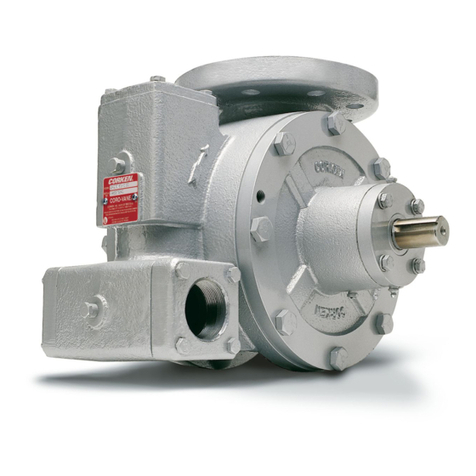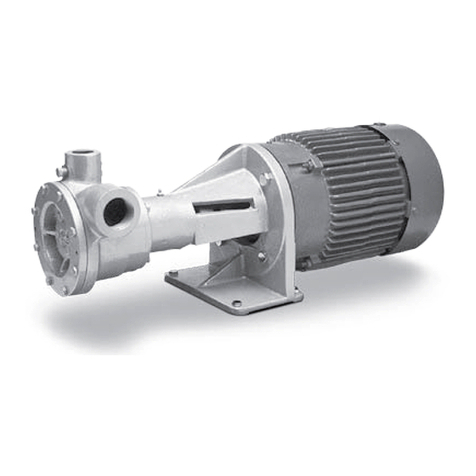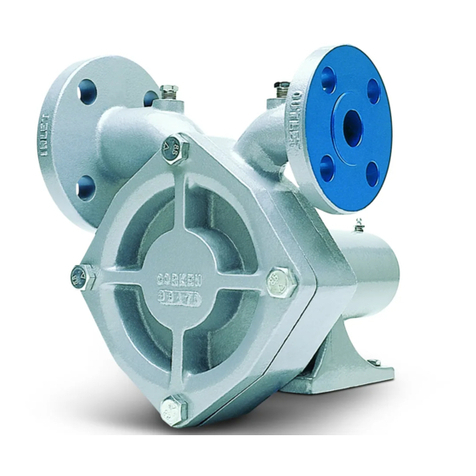
is under pressure by removing the flush seal plug.
Turning the adjusting screw clockwise will decreases
the internal relief valve setting. Replace the flush seal
plug after adjustment.
13.After initial operation, re-check the strainer screen.
Chapter 3—Maintenance Procedures
ALL REPAIRS TO THE PUMP MUST BE
PERFORMED BY QUALIFIED PERSONNEL IN A
SAFE MANNER, UTILIZING TOOLS AND/OR
EQUIPMENT THAT ARE FREE OF HAZARDS, AND
FOLLOWS THE APPLICABLE SAFETY CODES OF
PRACTICE SET BY THE LOCAL AUTHORITIES HAVING
JURISDICTION. MAKE SURE THE SYSTEM PRESSURE
HAS BEEN RELIEVED BEFORE ATTEMPTING ANY
REPAIR TO THE PUMP.
A pump requires regular maintenance and care like
all mechanical equipment. A neglected or improperly
repaired pump will result in premature failure and cause
unsafe conditions.
To promote product longevity and safety, maintenance
must be performed by properly trained technicians. Make
sure all safety systems are in place and the system pressure
has been relieved before attempting ANY maintenance.
Make sure the transfer hoses are not “kinked” which can
cause excessive pump discharge pressure. Always make
sure your hoses are not out of date.
There are two lubrication points in which to grease
the pump bearings; one zerk per bearing cap located
at opposite ends of the pump. Four grease relief and
seal ventilation fittings have been provided, two at
each end of the pump, to prevent overgreasing the
bearings. Overgreasing can cause seal failure if grease
passageways are blocked in some way. Clean each
fitting before lubricating the bearings. This practice helps
to prevent foreign-material contamination of the bearings
and accidental over-pressurization of the mechanical
seals. Use only ball bearing grease (MIL-G-10924C) with
a temperature rating of -50°F.
Normal wear parts are the mechanical shaft seals, bearings,
vanes and sideplates. All of these parts plus O-rings and
grease seals are offered in the Corken “repair kit” listed in
this manual directly after the Seal Replacement Instruction
on page 10. Use only genuine Corken replacement parts
when repairing the pump.
When it becomes necessary to repair your pump or
remove it from the system, you must be absolutely
certain that all propane, anhydrous ammonia or whatever
product being pumped is bled from the pump and
connecting piping. Once all the product has safely been
bled from the pump and connecting piping, make certain
no pressure is left in the system.
SPECIAL CARE MUST BE TAKEN DURING THE
BLEED DOWN PROCESS TO AVOID DANGER
TO PERSONNEL AND PROPERTY IN THE AREA.
Bleeding a system too fast is a common mistake and
may leave “refrigerated” liquid in the pump and piping
even though the pressure gauge shows no pressure.
As the “refrigerated” liquid begins to warm, more
gas will escape causing a dangerous condition. Take
your time in bleeding your system and make proper
provisions to vent or capture the gas in accordance
with local regulations. ONLY A PROPERLY TRAINED
INDIVIDUAL SHOULD BE ALLOWED TO BLEED A
PUMPING SYSTEM.
Pump Maintenance Schedule
Daily Monthly Three
Months
Lubricate bearings X
1
Inspect drive coupling X
Clean inlet strainer X
Check for leaks X
Inspect hose and fittings X
1 Continuous duty applications may require monthly lubrication.
Figure 3
If the pump’s use is seasonal, then special care must be
taken during the off season to protect your pump from
corrosion. If it is feasible and safe to keep the pump
pressurized with product during the off season, this will
prevent the entrance of any moisture or air. This system
should be checked periodically to make certain all of the
gas has not bled out.
If the pump is to be removed from service for some time,
the pump must be protected., as propane, butane and
anhydrous ammonia all leave the metal “bare” and open to
corrosion. Piping and tanks not in service should also be
protected, as the rust that forms can destroy the pump’s
seals almost immediately after start-up. To prevent these
problems, complete the following:
1. Fill or thoroughly flush the pump with a light rust
inhibiting oil. If the pump is flushed with oil, placing
some desiccant packets inside the pump will provide
added protection.
2. Plug all pump openings.
3. Store in a dry location.
4. Before placing the pump back into service, drain the
oil and remove any desiccant packets.
5. Before operating the pump, refer to chapter 2 of this
manual for operation procedures.
8
































